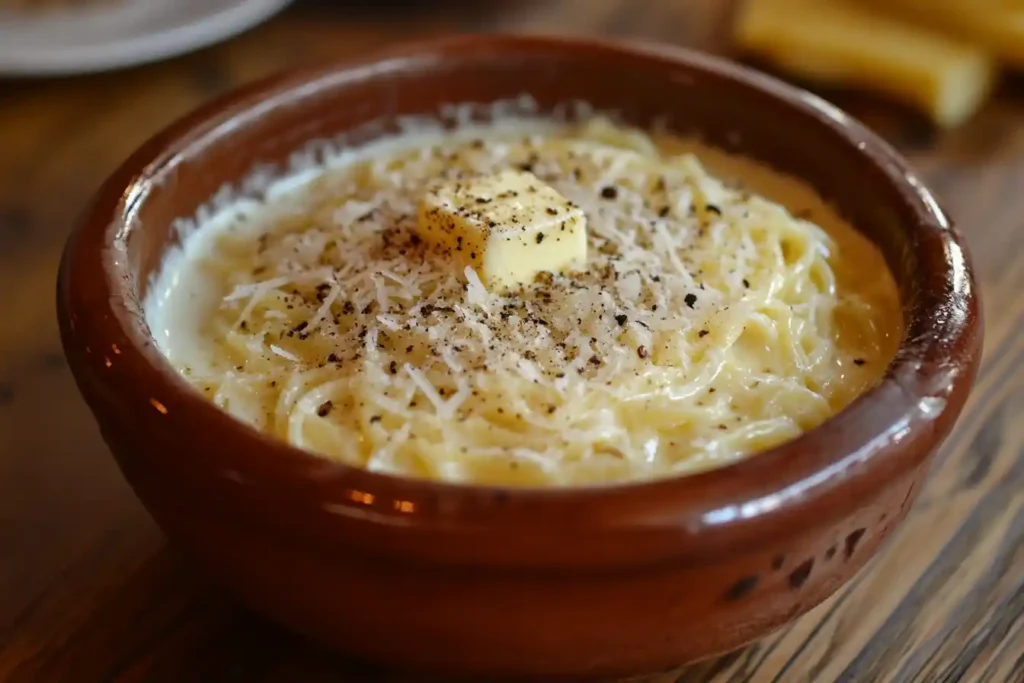Do they eat pastina in Italy? Absolutely! Italians embrace pastina as more than just food—it’s a tradition that brings comfort and warmth. Known as “little pasta”, it has earned a special place in Italian kitchens for its simplicity and versatility. Many families serve it as a first meal for babies, while others enjoy it as a quick remedy for colds.
Italians often rely on pastina when they need a light and easy-to-digest meal. Whether they prepare it in a warm broth or mix it with butter and cheese, it always satisfies. Its small size and soft texture make it appealing to both children and adults.
This article explores pastina’s origins, cultural importance, and preparation methods. It also highlights popular recipes, nutritional benefits, and modern adaptations that keep this tiny pasta relevant in contemporary Italian cuisine.
Table of Contents
What Is Pastina?

1. Definition and Origins of Pastina
Pastina means “little pasta” in Italian, and it describes the smallest pasta shapes available. Italians have used it for centuries as a comforting food for children and adults alike. Traditionally, families served it to soothe illnesses or simply as a quick and satisfying meal. Its tiny size and mild flavor make it an excellent choice for soups and light dishes.
2. Different Shapes and Varieties of Pastina
Pastina includes several small shapes, each suited for different preparations. Some of the most popular types are:
- Stelline – Tiny stars ideal for soups and broths.
- Acini di Pepe – Small, round beads often used in salads or soups.
- Orzo – Rice-shaped pasta that blends well with vegetables and sauces.
- Quadrettini – Small squares perfect for creamy or cheesy dishes.
- Farfalletti – Mini bowties that add visual appeal to lighter meals.
These shapes not only cook quickly but also absorb flavors effectively, making them versatile for various recipes.
3. How Pastina Differs from Other Types of Pasta
Unlike larger pasta varieties such as penne or fusilli, pastina often plays a supporting role rather than serving as the main ingredient. Its delicate size makes it ideal for soups and light broths rather than heavy sauces. While traditional pasta works as a standalone meal, pastina complements other ingredients like vegetables, cheese, and eggs.
Cultural Significance of Pastina in Italy
1. Traditional Italian Comfort Food
In Italy, pastina is more than just pasta—it’s a symbol of comfort and care. It’s often the first solid food given to babies as they transition from milk to solid meals. Parents prepare it with simple ingredients like broth, butter, and grated cheese, making it easy to digest and appealing to young palates. This association with nurturing makes pastina a go-to dish when someone is feeling under the weather or in need of a warm, soothing meal.
2. Pastina as a Childhood Staple
For Italian families, pastina holds sentimental value as a childhood staple. It’s the dish many people grow up eating, especially during colder months or when recovering from illness. The ease of preparation and its mild flavor make it a practical option for busy parents. Many Italians carry fond memories of their mothers or grandmothers preparing pastina, reinforcing its status as a comfort food tied to family traditions.
3. Use of Pastina in Italian Home Remedies
Pastina is often considered a home remedy in Italy. When someone is sick, especially with a cold or stomach upset, a bowl of pastina in brodo (pastina in broth) is frequently recommended. Its light texture makes it easy on the stomach, while the warm broth provides hydration and nutrients. Adding lemon juice or herbs can further enhance its soothing properties, turning it into a natural remedy to promote healing.
How Pastina Is Prepared in Italy
1. Simple Recipes for Everyday Meals
Italians value simplicity in cooking, and pastina perfectly embodies this principle. A basic recipe involves boiling pastina in salted water or broth, then stirring in butter, olive oil, and grated Parmesan cheese for a creamy texture. This dish, known as pastina al burro, is a quick and satisfying meal enjoyed by children and adults alike.
2. Common Ingredients Used with Pastina
While pastina itself is simple, the ingredients added to it can transform it into something special. Italians often pair pastina with:
- Broths (vegetable, chicken, or beef) for a rich, savory flavor.
- Cheese (Parmesan, Pecorino Romano) to add creaminess and depth.
- Eggs to create a protein-packed dish like pastina con l’uovo.
- Vegetables (carrots, zucchini, spinach) for a healthy, colorful addition.
- Herbs (parsley, basil, thyme) to enhance flavor and aroma.
3. Popular Regional Variations in Italy
Different regions in Italy have their unique ways of preparing pastina. In northern regions, it’s often served in a creamy consistency with butter and cheese. Southern areas may add tomatoes, garlic, and olive oil for a Mediterranean twist. In coastal regions, pastina may even be paired with seafood to create light yet flavorful dishes.
Nutritional Value and Benefits of Pastina
1. Health Benefits for Children and Adults
Pastina provides quick energy, making it ideal for growing children and busy adults. Its soft texture also makes it easy to digest, which is why many Italians serve it as a recovery meal for illnesses.
2. Nutritional Content: Carbs, Fiber, and Protein
Made from durum wheat semolina, pastina offers carbohydrates that fuel the body. Although it lacks fiber, adding vegetables can boost its fiber content. When paired with eggs or cheese, it also delivers protein, making it more filling.
3. Gluten-Free Alternatives to Traditional Pastina
Modern dietary trends have led to gluten-free pastina options made from rice, quinoa, or corn. These versions maintain the small size and versatility of traditional pastina, allowing people with gluten sensitivities to enjoy the dish without restrictions.
Popular Pastina Recipes in Italy

1. Pastina in Broth (Pastina in Brodo)
One of the most traditional ways to prepare pastina in Italy is by cooking it in a flavorful broth. Chicken or vegetable broth is typically used, and the pastina is simmered until tender. A drizzle of olive oil or a knob of butter is added for richness, while grated Parmesan cheese provides extra flavor. This simple and warming dish is especially popular during cold weather or when someone is feeling under the weather.
2. Creamy Pastina with Butter and Cheese
Another classic preparation involves cooking pastina and stirring in butter and freshly grated Parmesan or Pecorino Romano cheese. The result is a creamy and comforting dish similar to risotto but much quicker to prepare. Italians often serve this as a light lunch, dinner, or even a quick snack. For added creaminess, some recipes include a splash of cream or milk.
3. Egg Drop Pastina (Pastina con L’Uovo)
Pastina con l’uovo is a protein-packed variation where a beaten egg is stirred into the hot broth and pastina mixture. The egg cooks quickly, forming silky ribbons that add richness to the dish. This version is especially popular as a remedy for colds, providing warmth and nutrition in every spoonful. Fresh parsley or a sprinkle of black pepper can be added for extra flavor.
When Do Italians Eat Pastina?
1. Seasonal Preferences
Pastina is most commonly enjoyed during the colder months when warm and hearty dishes are favored. Its comforting texture and ability to warm the body make it a staple during fall and winter. However, it’s also a year-round favorite, especially in lighter variations served as quick meals or snacks.
2. Pastina as a Cold Remedy
In Italy, pastina is often considered a healing food. When someone is sick, a bowl of pastina in broth is one of the first meals prepared. Its mild flavor, easy digestibility, and soothing warmth make it a popular choice for recovering from illnesses like colds or stomach problems.
3. Breakfast, Lunch, or Dinner Options
Pastina is incredibly versatile and can be eaten at any time of day. It’s commonly served as a quick and light lunch or dinner but can also be prepared as a breakfast dish with milk and a sprinkle of sugar for a sweeter version. Many Italians even prepare it as a bedtime snack to end the day on a warm and comforting note.
Modern Uses of Pastina in Italian Cuisine
1. Incorporating Pastina into Soups and Stews
Modern chefs often use pastina in hearty stews and soups. Its small size blends seamlessly with other ingredients, enhancing texture and flavor.
2. Gourmet Twists on Traditional Pastina Recipes
Contemporary Italian chefs experiment with pastina by adding truffle oil, pancetta, and roasted vegetables. These variations appeal to food lovers looking for elegant versions of classic dishes.
3. Pastina in Contemporary Italian Restaurants
Pastina has also made its way into upscale Italian restaurants. Chefs present it as a refined dish, pairing it with gourmet ingredients and artistic plating.
Pastina Outside of Italy
1. Popularity in Italian-American Cuisine
Pastina has traveled far beyond Italy and become a staple in Italian-American households. In the United States, it’s especially popular among families of Italian descent who preserve the tradition of serving it as a comfort food. Many Italian-American recipes mirror those found in Italy, emphasizing simple, flavorful ingredients.
2. Influence on Global Cooking Styles
Thanks to globalization, pastina has made its way into kitchens around the world. Chefs and home cooks in different countries have adapted it into their cuisines, using it in soups, salads, and even casseroles. Its quick cooking time and versatility make it an appealing ingredient for international dishes.
3. Availability in International Markets
Once mainly found in Italian specialty stores, pastina is now widely available in supermarkets worldwide. It’s sold in both traditional wheat-based and gluten-free forms, making it accessible to diverse dietary needs. This global availability has contributed to its growing popularity outside Italy.
FAQs
1. Is pastina only eaten by children in Italy?
No, pastina is enjoyed by people of all ages in Italy. While it is commonly served to children, adults also eat it as a quick meal or comfort food.
2. What types of pastina are most popular in Italy?
Stelline, acini di pepe, and orzo are among the most popular types of pastina in Italy. These small shapes are ideal for soups and broths.
3. Is pastina healthy for adults?
Yes, pastina can be part of a healthy diet when paired with vegetables, broth, and lean proteins. Adding eggs or cheese provides extra nutrition.
4. Can pastina be made gluten-free?
Absolutely. Gluten-free pastina made from rice, corn, or quinoa is widely available, allowing those with gluten intolerance to enjoy it.
5. How is pastina typically served in Italy?
Pastina is most often served in broth, with butter and cheese, or with eggs for added richness. It’s versatile and can also be used in salads and casseroles.
6. Is pastina considered a soup or pasta dish in Italy?
Pastina is often served as a soup when cooked in broth, but it’s still classified as a type of pasta in Italian cuisine.
Conclusion
Pastina is more than just a type of pasta in Italy—it’s a culinary tradition deeply rooted in comfort, nourishment, and family values. Its small size and versatility make it a staple in Italian households, especially for children, the elderly, and anyone seeking a quick and soothing meal. Whether served in a warm broth, prepared with butter and cheese, or enhanced with eggs and herbs, pastina remains a symbol of simplicity and care.
Its cultural significance extends beyond Italy, as it has gained popularity in Italian-American cuisine and international kitchens. With modern adaptations and gluten-free options, pastina continues to evolve while staying true to its origins as a beloved comfort food.
From childhood memories to elegant modern recipes, pastina proves that even the smallest ingredients can create big flavors and lasting traditions. Whether you’re craving something light or rich, pastina is a timeless choice that connects generations through taste and tradition.
For more insights into pastina, check out What is the difference between pastina and stelline? and discover a comforting Pastina recipe with egg. If you’re curious about ingredients, learn Does pastina contain eggs?.

